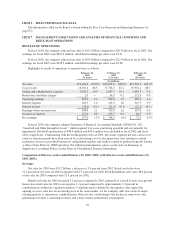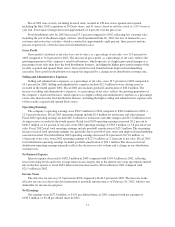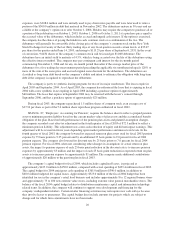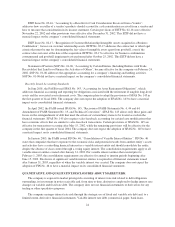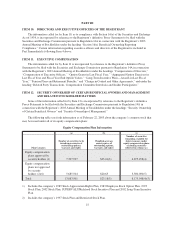Albertsons 2003 Annual Report Download - page 20
Download and view the complete annual report
Please find page 20 of the 2003 Albertsons annual report below. You can navigate through the pages in the report by either clicking on the pages listed below, or by using the keyword search tool below to find specific information within the annual report.expenses, were $208.0 million and were initially used to pay down notes payable and were later used to retire a
portion of the $300.0 million in debt that matured in November 2002. The debentures mature in 30 years and are
callable at the company’s option on or after October 1, 2006. Holders may require the company to purchase all or
a portion of their debentures on October 1, 2003, October 1, 2006 or October 1, 2011 at a purchase price equal to
the accreted value of the debentures, which includes accrued and unpaid cash interest. If the option is exercised,
the company has the choice of paying the holder in cash, common stock or a combination of the two. The
debentures will generally be convertible if the closing price of the company’s common stock on the New York
Stock Exchange for twenty of the last thirty trading days of any fiscal quarter exceeds certain levels, at $35.07
per share for the quarter ended June 14, 2003, and rising to $113.29 per share at September 6, 2031. In the event
of conversion, 9.6434 shares of the company’s common stock will be issued per $1,000 debenture. The
debentures have an initial yield to maturity of 4.5%, which is being accreted over the life of the debentures using
the effective interest method. The company may pay contingent cash interest for the six-month period
commencing November 3, 2006 and for any six-month period thereafter if the average market price of the
debentures for a five trading day measurement period preceding the applicable six-month period equals 120% or
more of the sum of the issue price and accrued original issue discount for the debentures. The debentures are
classified as long-term debt based on the company’s ability and intent to refinance the obligation with long-term
debt if the company is required to repurchase the debentures.
The company is party to synthetic leasing programs for two of its major warehouses. The leases expire in
April 2003 and September 2004. As of April 2003, the company has refinanced the lease that is expiring in fiscal
2004 with a new synthetic lease expiring in April 2008 including a purchase option of approximately
$60 million. The lease that expires in September 2004 may be renewed with the lessor’s consent through
September 2006, and has a purchase option of approximately $25 million.
During fiscal 2003, the company repurchased 1.5 million shares of common stock at an average cost of
$27.94 per share as part of the 5.0 million share repurchase program authorized in fiscal 2002.
SFAS No. 87, “Employers’ Accounting for Pension”, requires the balance sheet to reflect a prepaid pension
asset or minimum pension liability based on the current market value of plan assets and the accumulated benefit
obligation of the plan. Based on both performance of the pension plan assets and planned assumption changes,
the company recorded a net after-tax adjustment in the fourth quarter of fiscal 2003 of $72.3 million to reflect a
minimum pension liability. This adjustment was a non-cash reduction of equity and did not impact earnings. This
adjustment will be revised in future years depending upon market performance and interest rate levels. In the
fourth quarter of fiscal 2003, the company lowered its expected return on plan assets used for fiscal 2003 pension
expense by 75 basis points to 9.25 percent and by an additional 25 basis points to 9.0 percent for fiscal 2004
pension expense. The company also lowered its discount rate by 25 basis points to 7.0 percent for fiscal 2004
pension expense. For fiscal 2004, when not considering other changes in assumptions or actual return on plan
assets, the impact to pension expense of each 25 basis point reduction in the discount rate is to increase pension
expenses by approximately $3 million and the impact of each 25 basis point reduction in expected return on plan
assets is to increase pension expense by approximately $1 million. The company made additional contributions
of approximately $20 million to the pension plan in fiscal 2003.
The company’s capital budget for fiscal 2004, which includes capitalized leases, is projected at
approximately $425.0 million to $450.0 million, compared with actual spending of $439.4 million in fiscal 2003.
The capital budget for 2004 anticipates cash spending of $365.0 million to $390.0 million, in addition to
$60.0 million budgeted for capital leases. Approximately $325.0 million of the fiscal 2004 budget has been
identified for use in the company’s retail food business and includes approximately 8 to 12 regional banner stores
and approximately 75 to 100 new extreme value stores, including extreme value general merchandise stores. The
balance of the fiscal 2004 capital budget relates to distribution maintenance capital and information technology
related items. In addition, the company will continue to support store development and financing for the
company’s independent retailers. Certain retailer financing activities may not require new cash outlays because
they involve leases or guarantees. The capital budget does include amounts for projects which are subject to
change and for which firm commitments have not been made.
20


